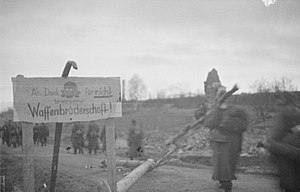| Lapland War | |||||||
|---|---|---|---|---|---|---|---|
| Part of the Eastern Front of World War II | |||||||
 A sign which the Germans left in Muonio, Lapland, written on it: 'As thanks for not demonstrating brotherhood in arms!' | |||||||
| |||||||
| Belligerents | |||||||
|
|
Minor air support: | ||||||
| Commanders and leaders | |||||||
| Strength | |||||||
| 214,000[b] | 75,000[c] | ||||||
| Casualties and losses | |||||||
|
| ||||||
During World War II, the Lapland War (Finnish: Lapin sota; Swedish: Lapplandskriget; German: Lapplandkrieg) saw fighting between Finland and Nazi Germany – effectively from September to November 1944 – in Finland's northernmost region, Lapland. Though the Finns and the Germans had been fighting together against the Soviet Union since 1941 during the Continuation War (1941–1944), peace negotiations between the Finnish government and the Allies of World War II had been conducted intermittently during 1943–1944, but no agreement had been reached.[9] The Moscow Armistice, signed on 19 September 1944, demanded that Finland break diplomatic ties with Germany and expel or disarm any German soldiers remaining in Finland.
The Wehrmacht had anticipated this turn of events and planned an organised withdrawal to Nazi-occupied Norway, as part of Operation Birke (Birch). Despite a failed offensive landing operation by Germany in the Gulf of Finland, the evacuation proceeded peacefully at first. The Finns escalated the situation into warfare on 28 September after Soviet pressure to adhere to the terms of the armistice. The Finnish Army was required by the Soviet Union to push Wehrmacht troops out of Finnish territory. After a series of minor battles, the war came to an effective end in November 1944, when all of the Wehrmacht troops had reached Norway or the border area and took fortified positions. The last Wehrmacht soldiers left Finland on 27 April 1945, shortly before the end of World War II in Europe.
The Finns considered the war a separate conflict because hostilities with other nations had ceased after the Continuation War. From the German perspective, it was a part of the two campaigns to evacuate from northern Finland and northern Norway. Soviet involvement in the war amounted to monitoring Finnish operations, minor air support and entering northeastern Lapland during the Petsamo–Kirkenes Offensive. The military impact was relatively limited with both sides sustaining around 4,000 in total casualties, although the Germans' delaying scorched earth and land mine strategies devastated Finnish Lapland. The Wehrmacht successfully withdrew, and Finland upheld its obligations under the Moscow Armistice, but it remained formally at war with the Soviet Union and the United Kingdom until ratification of the 1947 Paris Peace Treaty.
- ^ Gebhardt 1989, pp. 2–4.
- ^ Ziemke 2002, pp. 391–401.
- ^ Jowett & Snodgrass 2012, p. 16.
- ^ Zabecki 2015, p. 1552.
- ^ Jaques 2007, p. 792.
- ^ Elfvengren 2005, pp. 1124–1149.
- ^ Kurenmaa & Lentilä 2005, pp. 1150–1162.
- ^ a b Ahto 1980, p. 296.
- ^ Reiter 2009, pp. 134–137.
Cite error: There are <ref group=lower-alpha> tags or {{efn}} templates on this page, but the references will not show without a {{reflist|group=lower-alpha}} template or {{notelist}} template (see the help page).